Bone Health Calculator
Calculate your daily calcium and vitamin D needs based on age, gender, and current intake. This tool helps ensure you're meeting recommendations for stronger bones as you age.
Your Results
Calcium Needs:
Vitamin D Needs:
Why Bones Change With Age
When you get older, your skeleton doesn’t stay the same. The natural slowdown of bone remodeling means new bone forms more slowly than old bone is broken down. This imbalance can lead to thinner, weaker bones over time.
Aging is a biological process that affects every tissue in the body, including the skeletal system. As cells that build bone (osteoblasts) become less active and cells that break down bone (osteoclasts) stay relatively active, bone mineral density declines.
Men typically lose bone mass after age 50, while women experience a sharper drop around menopause because estrogen levels fall dramatically. Understanding these hormonal shifts is the first step in protecting your skeleton.
Key Factors That Influence bone health
Several interrelated elements determine how strong your bones stay:
- Calcium is the primary mineral that makes up bone tissue. Adults need about 1,000mg per day; women over 50 and men over 70 should aim for 1,200mg.
- Vitamin D helps the gut absorb calcium. The Institute of Medicine recommends 800-1,000IU daily for seniors.
- Exercise, especially weight‑bearing and resistance activities, stimulates bone‑forming cells.
- Hormones like estrogen and testosterone play a protective role; their decline with age is a major driver of bone loss.
- Nutrition beyond calcium and vitamin D - protein, magnesium, potassium, and vitamin K2 all contribute to bone matrix quality.
- Fall risk - the likelihood of a tumble rises with age, and a fall can cause a fracture even in relatively healthy bone.
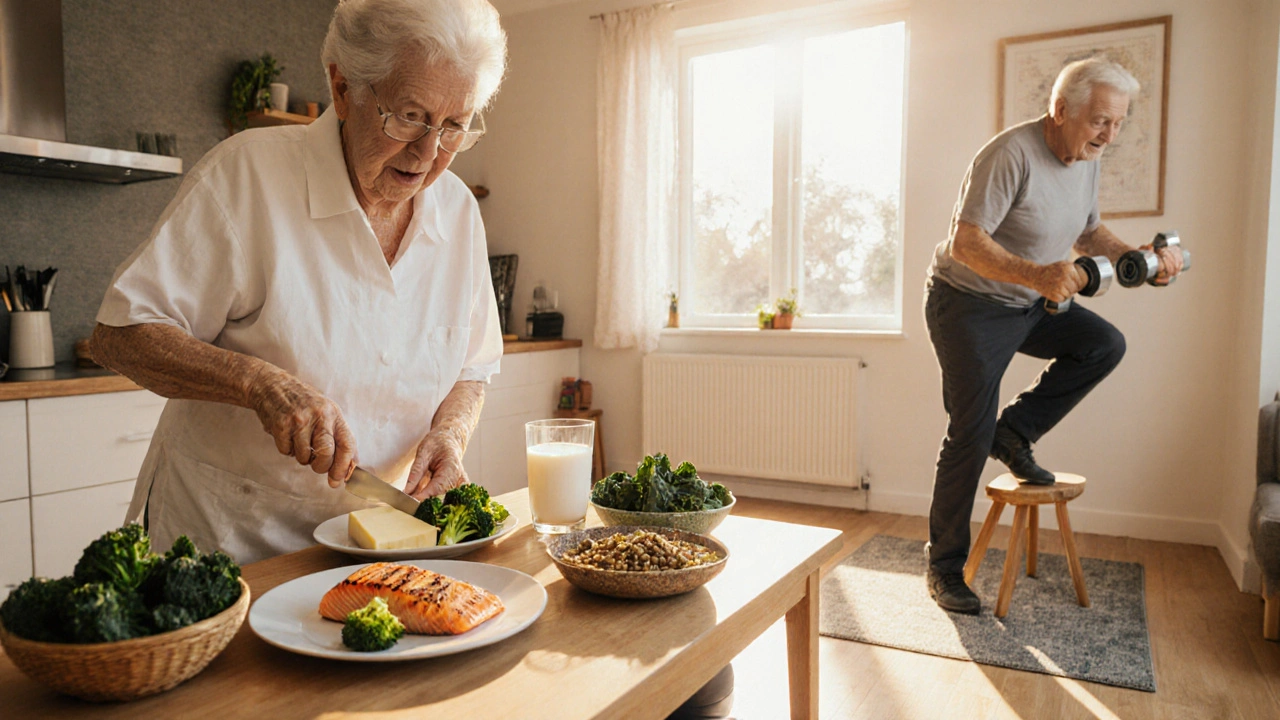
Nutrition Strategies for Healthy Bones
Getting the right nutrients isn’t just about popping a pill; it’s about building a balanced plate.
Calcium‑rich foods include low‑fat dairy (milk, yogurt, cheese), fortified plant milks, sardines with bones, and leafy greens like kale and bok choy. One cup of fortified soy milk can deliver around 300mg of calcium.
Vitamin D sources are a bit trickier. Fatty fish (salmon, mackerel), egg yolks, and mushrooms exposed to UV light provide modest amounts. Sun exposure - about 10‑15minutes of midday sun on face and arms - can synthesize up to 1,000IU for many people, but geographic location and skin tone matter.
Don’t forget protein. Older adults need about 1.0‑1.2g per kilogram of body weight daily to support bone matrix. A serving of grilled chicken breast (30g protein) or a cup of lentils (18g protein) works well.
Other supportive nutrients:
- Magnesium - nuts, seeds, whole grains (400‑420mg daily)
- Potassium - bananas, sweet potatoes (2,500mg daily)
- Vitamin K2 - natto, hard cheeses (90‑120µg daily)
When diet alone falls short, consider a supplement that combines calcium (500‑600mg) with vitamin D (800‑1,000IU). Choose a product that lists “elemental calcium” to avoid over‑counting the weight of calcium carbonate.
Exercise Moves That Boost Bone Density
Weight‑bearing activities force the skeleton to bear load, prompting bone formation. Here are three categories you can mix into a weekly routine:
- Impact activities: brisk walking, stair climbing, low‑impact aerobics, or dancing. Aim for 30 minutes, five days a week.
- Resistance training: dumbbell squats, leg presses, or resistance‑band rows. Perform 2‑3 sessions per week, 8‑12 reps per set, focusing on major muscle groups.
- Balance & flexibility: tai chi, yoga, or simple heel‑to‑toe walks. These reduce fall risk, complementing the bone‑building benefits of the first two.
Start slowly if you’re new to exercise. A 45‑year‑old beginner can begin with 10‑minute walks, gradually adding 5 minutes each week. Consistency beats intensity when it comes to bone health.
Lifestyle Habits to Reduce Fall Risk
Even the strongest bones can break if you hit the floor. Simple changes can keep you steady:
- Footwear: Choose shoes with non‑slip soles and good arch support. Avoid high heels and floppy slippers.
- Home safety: Install grab bars in the bathroom, secure loose rugs, and ensure adequate lighting on stairs.
- Vision checks: Eyesight problems double fall risk. Get an eye exam at least once a year after age 60.
- Avoid smoking & excess alcohol: Smoking impairs calcium absorption, and more than three drinks a day can increase bone loss.
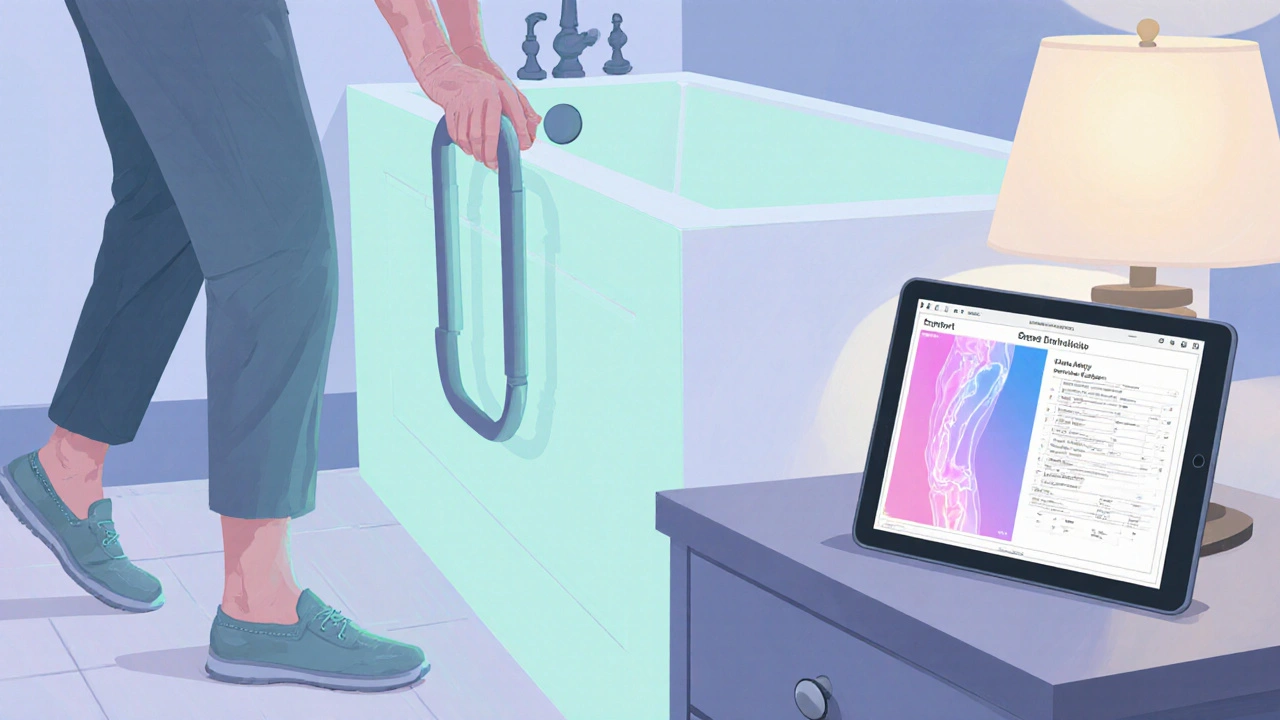
Monitoring Bone Health: Tests and Red Flags
Regular screening helps catch trouble early. The gold‑standard test is a bone density scan (DXA). It measures the amount of mineral in the hip and spine and reports results as a T‑score.
Guidelines suggest:
- Women aged 65+ and men aged 70+ get a baseline DXA.
- Post‑menopausal women under 65 should be screened if they have risk factors like low body weight, smoking, or a family history of fractures.
Red‑flag symptoms that merit immediate medical attention include:
- Sudden, severe back pain (possible vertebral fracture)
- Height loss of more than 2cm
- Persistent hip or wrist pain after a minor fall
If any of these appear, contact a healthcare professional promptly. Early treatment with medications such as bisphosphonates can halt bone loss and reduce fracture risk.
Quick Takeaways
- Bone loss accelerates after age 50; hormones, nutrition, and activity are the main levers you can control.
- Aim for 1,200mg calcium and 800‑1,000IU vitaminD daily, plus adequate protein and other minerals.
- Incorporate weight‑bearing, resistance, and balance exercises at least three times a week.
- Make home and lifestyle tweaks to prevent falls.
- Get a DXA scan at recommended ages or sooner if you have risk factors.
Frequently Asked Questions
How much calcium do seniors really need?
Adults 51years and older should target about 1,200mg of elemental calcium each day. This can be split between food (800‑900mg) and a supplement (300‑400mg) if dietary intake is insufficient.
Is vitamin D supplementation safe for everyone?
For most adults, 800‑1,000IU daily is safe and effective. People with certain medical conditions (e.g., hypercalcemia) should talk to a doctor before starting high doses.
Can I build bone after age 60?
Yes. While the rate of bone formation slows, regular weight‑bearing exercise and adequate nutrition can increase bone density modestly and reduce fracture risk.
What’s the best exercise for preventing osteoporosis?
A combination works best: brisk walking or dancing for impact, resistance‑band or dumbbell workouts for strength, and tai chi for balance.
How often should I get a bone density scan?
If your initial scan is normal, repeat every 2‑3years. More frequent testing may be needed if you start osteoporosis medication or have rapid bone loss.
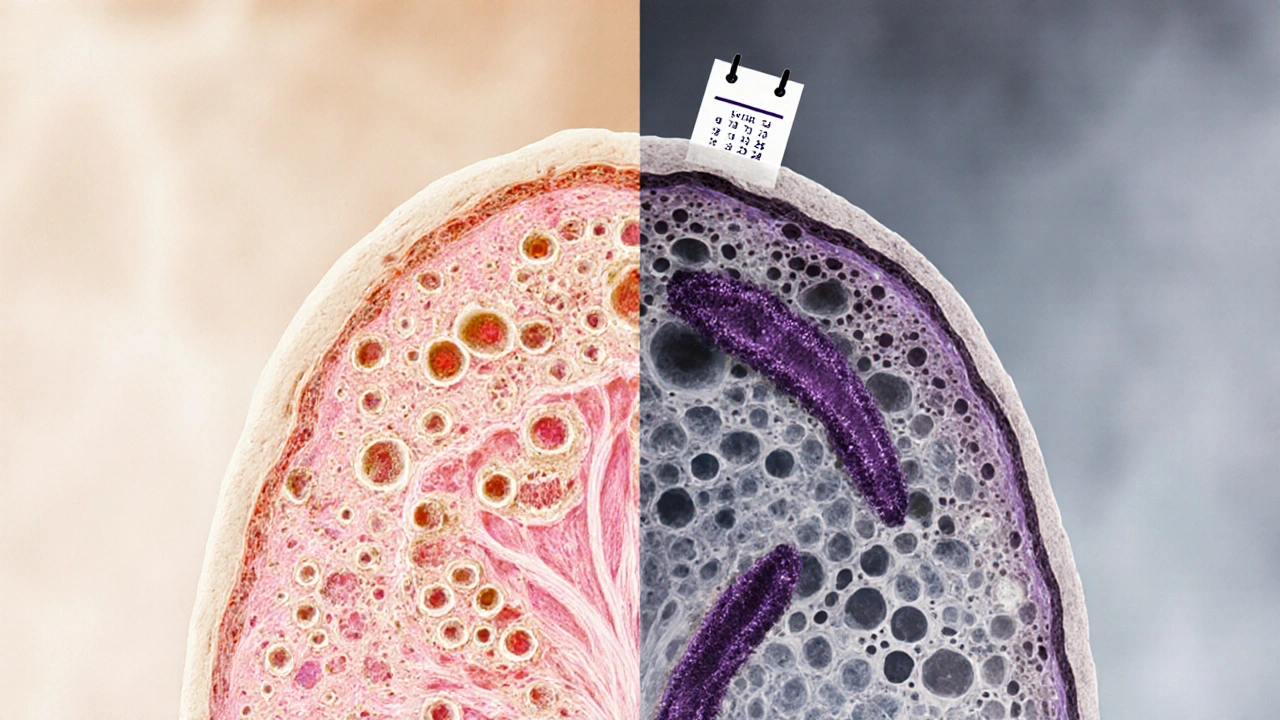
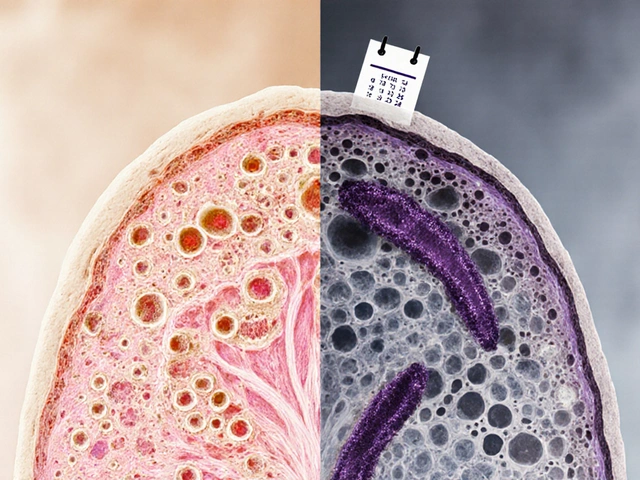
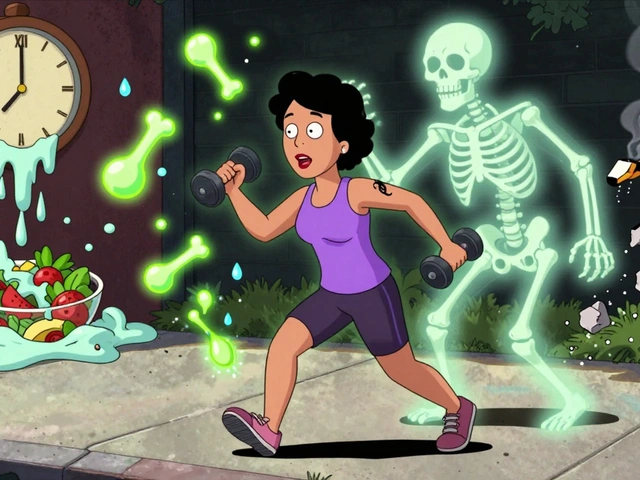
I'm not surprised the article pushes calcium supplements like they're some secret weapon-obviously the pharma lobby is behind every "essential tip". The whole thing feels like a guilt trip for anyone who doesn't already stock up on pills. Honestly, I'd rather ignore it.
One might contemplate, in the grand tapestry of human existence, the paradox of bone rigidity; a structure both fragile and resilient, ensnared within the biological imperatives of calcium and vitamin D. Did the ancients ever foresee that their marrow would be quantified by milligrams and International Units? Thus, the discourse ascends beyond mere nutrition into the realm of ontological inquiry.
The bone health calculator referenced in the article is a practical implementation of the principle of calcium homeostasis, integrating age‑specific basal requirements with user‑reported intake to estimate net deficits.
Osteoblastogenesis, the process by which mesenchymal stem cells differentiate into bone‑forming cells, is highly sensitive to extracellular calcium concentrations, making accurate quantification essential.
Serum 25‑hydroxyvitamin D (25(OH)D) levels, the principal biomarker for vitamin D status, modulate intestinal calcium absorption via the calcium‑binding protein calbindin‑D9k.
When the calculator flags a calcium shortfall, the recommended dietary sources-fortified soy milk, low‑fat yogurt, and skeletal fish such as sardines-provide elemental calcium in bioavailable forms, often complexed with phosphate to enhance solubility.
Vitamin D recommendations of 800–1,000 IU per day align with the Endocrine Society's guidelines for individuals over 50, aiming to maintain serum 25(OH)D concentrations above 30 ng/mL.
Excessive supplementation, however, can precipitate hypercalcemia, leading to ectopic calcification and renal stone formation, so the calculator's feedback loop is valuable for titrating intake.
Resistance training triggers mechanotransduction pathways, notably the Wnt/β‑catenin cascade, which upregulates osteoblast activity and attenuates osteoclastogenesis.
Balance exercises such as tai chi reduce fall incidence by improving proprioceptive feedback and neuromuscular coordination, thereby decreasing fracture risk independent of bone mineral density.
The article’s emphasis on protein intake-approximately 1.0–1.2 g·kg⁻¹·day⁻¹-supports the synthesis of collagen type I, the organic matrix scaffold for mineral deposition.
Magnesium acts as a cofactor for alkaline phosphatase, an enzyme pivotal in hydroxyapatite crystal formation, while potassium buffers acid load to mitigate calcium leaching from bone.
Vitamin K₂, especially menaquinone‑7, facilitates γ‑carboxylation of osteocalcin, enhancing calcium binding within the matrix.
For individuals with limited sun exposure, the calculator’s suggestion to consider supplementation is prudent, provided renal function is monitored.
Bone densitometry (DXA) remains the gold standard for assessing areal bone mineral density, with T‑scores informing pharmacologic interventions such as bisphosphonates or denosumab when indicated.
Lifestyle modifications-cessation of tobacco, moderation of alcohol intake, and ensuring adequate lighting at home-complement nutritional and exercise strategies.
In sum, the interactive tool operationalizes evidence‑based recommendations into an actionable personal plan, empowering users to address deficiencies before they manifest clinically. :)
Thank you for the comprehensive breakdown; the depth of detail makes the recommendations far more actionable. I especially appreciate the connection between mechanotransduction pathways and everyday resistance training-often an overlooked link in popular health posts. Your inclusion of micronutrients beyond calcium and vitamin D highlights the multifactorial nature of skeletal integrity. This balanced perspective should inspire readers to adopt a holistic approach rather than fixating on a single nutrient.
While the article touts supplements as harmless, one must consider the hidden agendas of corporations that profit from chronic deficiency narratives; the push for fortified foods is no accident-it's a market-driven strategy to keep consumers dependent. Moreover, the advice to bask in sunlight ignores the reality of UV‑induced DNA damage, a fact conveniently downplayed by health ministries. The so‑called “gold‑standard” DXA scans are not immune to industry bias either; imaging equipment manufacturers influence diagnostic thresholds to expand the pool of “at‑risk” patients. Therefore, readers should approach these guidelines with healthy skepticism.